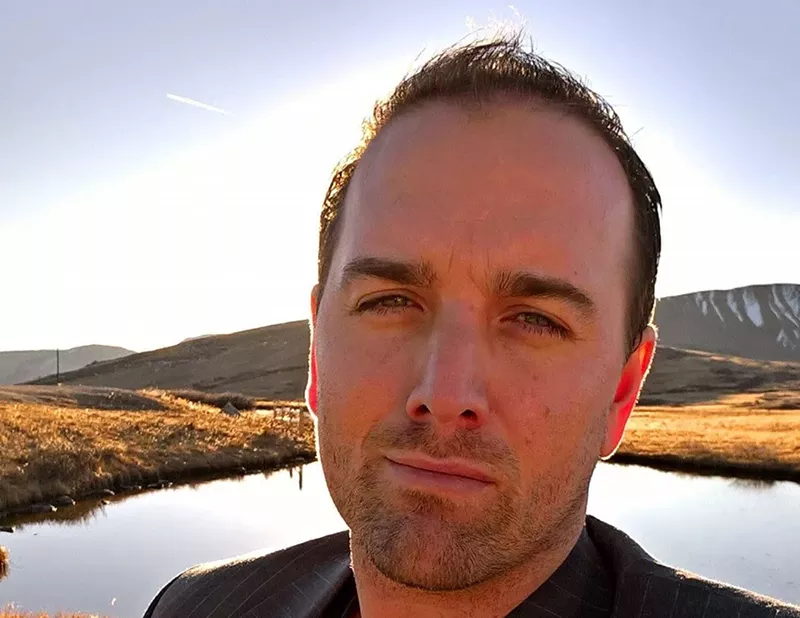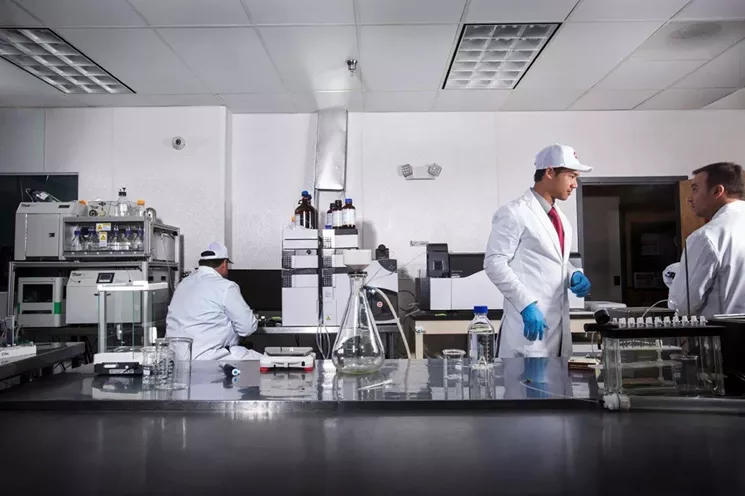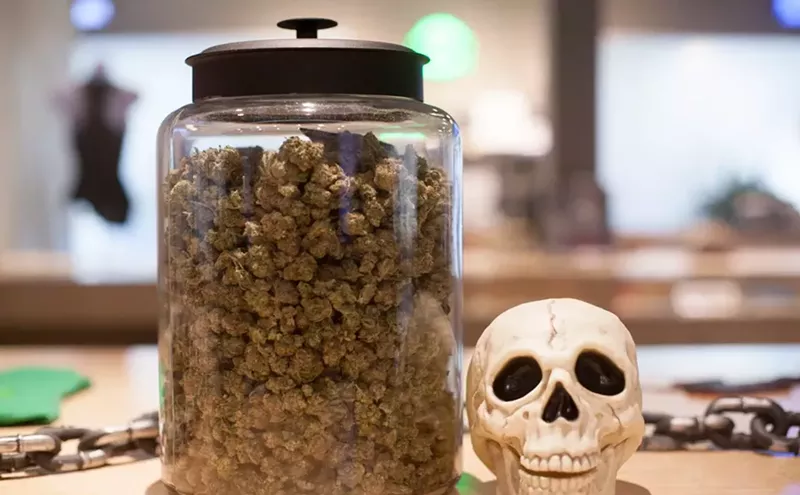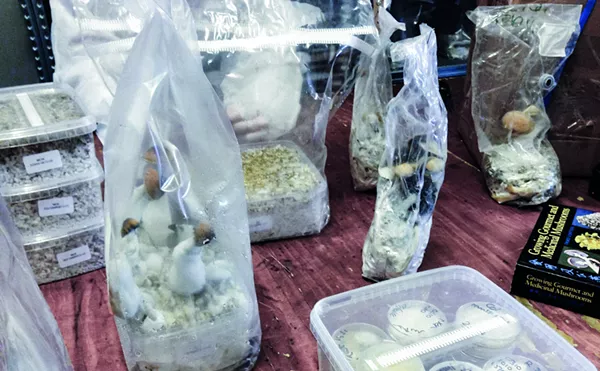Sales data has shown a consistent growth in cannabis extracts and other forms of consumption as the legal pot industry advances. While part of the allure is sheer novelty, many new technologies have given medical patients more standardized treatment and retail users more consistent effects.
Colorado extraction company Ebbu's products are known for unconventional consumption methods, like its water-infusing THC drops that landed the company a partnership with Blue Moon creator Keith Villa to manufacturer a THC-infused, non-alcoholic beer. The company represents a shift toward chemistry in the legal cannabis community, mapping out the vast and varying constellations of different cannabinoids. But what can the plant's genetic makeup do for mankind as we learn more about it? We chatted with Ebbu general manager Damon Michaels to find out.
Westword: How can scientists use chemistry and techniques like molecular isolation to advance medical and retail cannabis?
Damon Michaels: The technology of isolating cannabinoids and terpenoids from cannabis plants allows Ebbu’s cellular pharmacology team to introduce specific individual compounds to receptor cells, then measure how the cells react in real time. We can then introduce various combinations of cannabinoid and terpene compounds called “isolate formulations” and measure that unique reaction. From these results, our psychopharmacology team can duplicate these isolate formulations to test with human volunteers, who report how each formulation affects their mood state. Through a process of tweaking the formulations, we can introduce products for the medical and adult-use markets that we can have a high degree of certainty will produce a consistent, reliable reaction in consumers.
Every stoner knows what kief is, but what are trichomes? What makes cannabis trichomes unique? What do they hold that gives strains their characteristics?
Trichomes are the shiny, sticky resin glands that appear on the buds and leaves of the cannabis plant in the later stages of growth. Their job during cultivation is to protect the plant by repelling insects and animals — but Ebbu has a high interest in them because trichomes are where cannabinoids like THC, CBD and so on, and terpenoids such as limonene, myrcene and pinene, are generated. Think of trichomes like micro-chemical factories.
THC and CBD get all the attention, but what are some other cannabinoids to look out for, and what are their medical benefits/effects?
Our scientists are definitely excited about the medical potential of these rarer cannabinoids. In fact, our expert genetics team has been working on leveraging the diversity of cannabis strains to isolate specific rare cannabinoids. Ebbu geneticists are also working on editing cannabis plants using a tool called crispr/cas9 to become more efficient at producing higher yields of cannabinoids.
Among cannabinoids of interest to us and other cannabis scientists are CBN (cannabinol), CBG (cannabigerol), CBC (cannabichromene) and THCV (tetrahydrocannabivarin), to name a few. CBN is becoming known for its soporific (sleep-inducing) effects, and researchers are looking at CBC for pain relief and CBG for fighting cancer. But even more important than discovering what these cannabinoids do in isolation is using them in combination with each other — and also in harmony with terpenes — to take advantage of the entourage effect.
Your company is known for its water-infusion technology, but what are some other ways consumers can ingest cannabinoids nowadays besides smoking or standard edibles?
Ebbu's water-soluble products have attracted a lot of interest because of the fast growth of the infused-beverage market in this space. Looking ahead, delivery systems like eye drops and sublingual sprays and so forth may become the administration of choice for certain medical marijuana patients and adult-use consumers. Other methods of delivery include nasal sprays, transdermal patches and transmucosal suppositories.
How would you compare the consistency of effects of cannabis flower compared to extractions? Will smoking flower still be considered "medical marijuana" in the next ten years?
When you’re smoking flower or consuming whole-plant extracts, true consistency goes out the window. There’s a multitude of factors in play: the strain itself, nutrients used in cultivation, harvesting timing and methodology, curing, etc. Most people show their interest in the genotype or the phenotype of the cannabis plant, but our scientists primarily focus on the chemotype profile, or the specific chemical compounds that each plant produces. At Ebbu, we call consuming flower or general extracts “chemical chaos,” because Mother Nature will never produce a consistent chemotype profile.
Mainstream adoption of cannabinoid products will occur only when consumers feel confident that they are getting a reliable result each time they use a product that they can trust time and time again. The cannabis brands of tomorrow will heed this consumer demand for consistency and use commercial extraction and purification techniques to produce formulations to be used in distinguished products with specific, known, reliable, predictable sensations and medical effects.
How much more is left to be done in mapping out the cannabinoids, terpenes and other compounds inside a cannabis plant? Is it a map that will ever be completed?
We know there are over 100 cannabinoids and over 200 terpenes found in cannabis. We’ve only touched the tip of the iceberg in discovering what each of them can do on their own, and then there are thousands of potential isolate formulation combinations. If we did a combination of just three isolate compounds — one cannabinoid (THC) and two terpenes (myrcene and limonene) — it would create over 800,000 combinations, so we have a long way to go. Research in this country has been hampered by the federal status of cannabis, but Israel, Canada and other countries that have more progressive approaches to cannabis are making good headway. That said, I’d put Ebbu’s scientific team up against any in the world in being a leading cannabinoid research company.
Send suggestions for future interview subjects to [email protected].

Audio By Carbonatix
[
{
"name": "GPT - Billboard - Slot Inline - Content - Labeled - No Desktop",
"component": "23668565",
"insertPoint": "2",
"requiredCountToDisplay": "2"
},{
"name": "STN Player - Float - Mobile Only ",
"component": "23853568",
"insertPoint": "2",
"requiredCountToDisplay": "2"
},{
"name": "Editor Picks",
"component": "17242653",
"insertPoint": "4",
"requiredCountToDisplay": "1"
},{
"name": "Inline Links",
"component": "18838239",
"insertPoint": "8th",
"startingPoint": 8,
"requiredCountToDisplay": "7",
"maxInsertions": 25
},{
"name": "GPT - 2x Rectangles Desktop, Tower on Mobile - Labeled",
"component": "24956856",
"insertPoint": "8th",
"startingPoint": 8,
"requiredCountToDisplay": "7",
"maxInsertions": 25
},{
"name": "Inline Links",
"component": "18838239",
"insertPoint": "8th",
"startingPoint": 12,
"requiredCountToDisplay": "11",
"maxInsertions": 25
},{
"name": "GPT - Leaderboard to Tower - Slot Auto-select - Labeled",
"component": "17676724",
"insertPoint": "8th",
"startingPoint": 12,
"requiredCountToDisplay": "11",
"maxInsertions": 25
}
]













